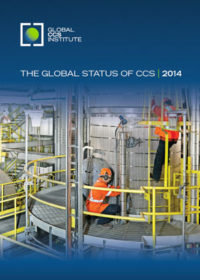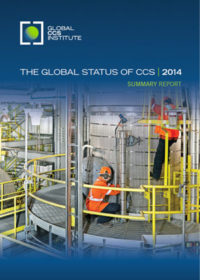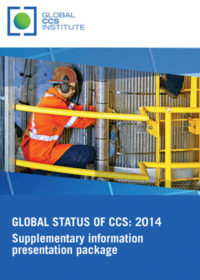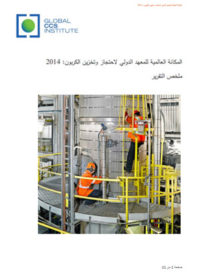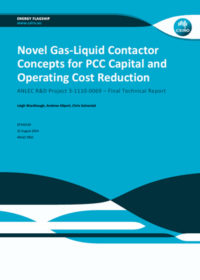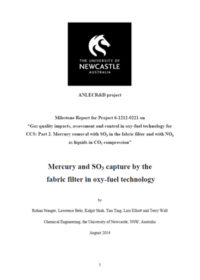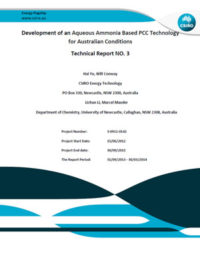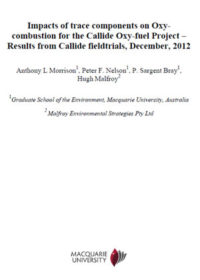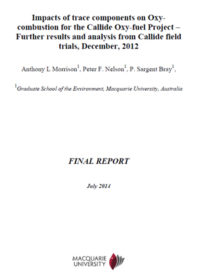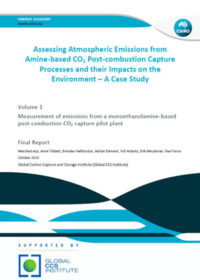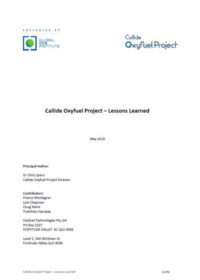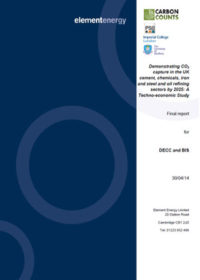Resources
Publications
Our publications, reports and research library hosts over 500 specialist reports and research papers on all topics associated with CCS.
View our Publication Library Disclaimer.
Filter by
The Global Status of CCS: 2014
5th November 2014
Topic(s): Carbon capture use and storage (CCUS), CO2 capture, CO2 storage, CO2 transport, CO2 utilisation
The Global CCS Institute is pleased to announce the release of our Global Status of CCS: 2014 report.
The report provides a detailed overview of the current status of large-scale CCS projects worldwide, finding that 2014 has been a pivotal year for CCS, which is now a reality in the power industry.
For the first time, the report introduces and provides links to project descriptions for around 40 lesser scale ‘notable’ CCS projects. The 2014 report focuses on a number of ‘notable’ projects in Japan.
The Global Status of CCS: 2014 report provides a comprehensive overview of global and regional developments in CCS and what is required to support global climate mitigation efforts. Providing a number of key recommendations for decision makers, The Global Status of CCS: 2014 report is an important reference guide for industry, government, research bodies and the broader community.
Supplementary Information Presentation Package
Disclaimer
The content within the Global CCS Institute Publications, Reports and Research Library is provided for information purposes only. We make every effort and take reasonable care to keep the content of this section up-to-date and error-free. However, we make no claim as to its accuracy, currency or reliability.
Content and material featured within this section of our website includes reports and research published by third parties. The content and material may include opinions and recommendations of third parties that do not reflect those held by the Global CCS Institute.
The Global Status of CCS: 2014 Summary Report
5th November 2014
Topic(s): Carbon capture use and storage (CCUS), CO2 capture, CO2 storage, CO2 transport, CO2 utilisation
The Global Status of CCS: 2014 Summary Report provides an executive overview of the key findings and recommendations contained in the Institute’s Global Status of CCS: 2014 report.
Disclaimer
The content within the Global CCS Institute Publications, Reports and Research Library is provided for information purposes only. We make every effort and take reasonable care to keep the content of this section up-to-date and error-free. However, we make no claim as to its accuracy, currency or reliability.
Content and material featured within this section of our website includes reports and research published by third parties. The content and material may include opinions and recommendations of third parties that do not reflect those held by the Global CCS Institute.
The Global Status of CCS: 2014 Supplementary Information Presentation Package
5th November 2014
Topic(s): Carbon capture use and storage (CCUS), CO2 capture, CO2 storage, CO2 transport, CO2 utilisation
The Supplementary Information presentation package includes chart materials not included in the Global Status of CCS: 2014 report. This material provides additional detail on the status of large-scale CCS projects globally. When used in conjunction with previous status reports, it provides researchers with access to the world’s most comprehensive historical data set on large-scale CCS projects.
Disclaimer
The content within the Global CCS Institute Publications, Reports and Research Library is provided for information purposes only. We make every effort and take reasonable care to keep the content of this section up-to-date and error-free. However, we make no claim as to its accuracy, currency or reliability.
Content and material featured within this section of our website includes reports and research published by third parties. The content and material may include opinions and recommendations of third parties that do not reflect those held by the Global CCS Institute.
المكانة العالمية للمعهد الدولي لاحتجاز وتخزين الكربون | 2014
5th November 2014
Topic(s): Carbon capture use and storage (CCUS), CO2 capture, CO2 storage, CO2 transport, CO2 utilisation
تم البدء بتنفيذ أول مشروع في العالم لاحتجاز وتخزين الكربون على النطاق الواسع في قطاع الطاقة في شهر تشرين الأول من عام 2014 على محطة كهرباء باونداري دام في ساسكاتشوان، كندا. ومن المقرر أن يدخل مشروعان إضافيان لاحتجاز وتخزين الكربون على النطاق الواسع حيز التنفيذ في قطاع الطاقة- في مرفق مقاطعة كمبر للطاقة في ولاية الميسيسيبي ومشروع بترا نوفا لاحتجاز الكربون في ولاية تكساس في عامي 2015 و2016 على التوالي. ويجري أيضاً العمل على أول مشروع في العالم لاحتجاز وتخزين الكربون على النطاق الواسع في قطاع الحديد والصلب، ومشروع أبو ظبي لاحتجاز وتخزين الكربون في الإمارات العربية المتحدة. وهذه المشاريع الأربعة هي من بين 22 مشروع لاحتجاز وتخزين الكربون على النطاق الواسع التي يجري العمل عليها أو تنفيذها في جميع أنحاء العالم- وهو ضعف الرقم الذي كان في بداية هذا العقد.
Disclaimer
The content within the Global CCS Institute Publications, Reports and Research Library is provided for information purposes only. We make every effort and take reasonable care to keep the content of this section up-to-date and error-free. However, we make no claim as to its accuracy, currency or reliability.
Content and material featured within this section of our website includes reports and research published by third parties. The content and material may include opinions and recommendations of third parties that do not reflect those held by the Global CCS Institute.
Novel gas-liquid contactor concepts for PCC capital and operating cost reduction
25th August 2014
Topic(s): Carbon capture use and storage (CCUS), CO2 capture, Economics
ANLEC R&D funded this CSIRO technical report that describes the development of a novel gas-liquid contactor aimed at reducing the capital and operating costs of Post Combustion Capture (PCC) commercial scale plants.
This project developed an innovative contactor which aimed to improve the economics of post combustion capture (PCC). The contactor design reduces the size of the column and eliminated the column packing, which enables an overall capital cost reduction of 30% and a power consumption reduction of 25%. Process optimisation in PCC deployment at scale will validate performance. However the concept has demonstrated excellent potential for cost savings and can be applicable to many existing technologies and processes.
Disclaimer
The content within the Global CCS Institute Publications, Reports and Research Library is provided for information purposes only. We make every effort and take reasonable care to keep the content of this section up-to-date and error-free. However, we make no claim as to its accuracy, currency or reliability.
Content and material featured within this section of our website includes reports and research published by third parties. The content and material may include opinions and recommendations of third parties that do not reflect those held by the Global CCS Institute.
Mercury and SO3 capture by the fabric filter in oxy-fuel technology
1st August 2014
Topic(s): Carbon capture use and storage (CCUS), CO2 capture
This project continues to study mercury removal from Oxy-fuel flue gas to reduce the associated costs and risks. It aims to quantify the extent of removal and the impact of impurities (SO3 and NOx) in the CO2. This report focuses on removing mercury with the presence of SO3 in the fabric filter. It concludes that, for practical carbon-in-ash levels, the competition between mercury and SO3 by ash can be neglected.
Disclaimer
The content within the Global CCS Institute Publications, Reports and Research Library is provided for information purposes only. We make every effort and take reasonable care to keep the content of this section up-to-date and error-free. However, we make no claim as to its accuracy, currency or reliability.
Content and material featured within this section of our website includes reports and research published by third parties. The content and material may include opinions and recommendations of third parties that do not reflect those held by the Global CCS Institute.
Development of an aqueous ammonia based PCC technology for Australian conditions: technical report no. 3
11th July 2014
Topic(s): Carbon capture use and storage (CCUS), CO2 capture
Post combustion capture of CO2 in power generation using commercial amines results in a significant efficiency loss (25-30%). Using an aqueous ammonia solvent can reduce this loss because it has nearly double the carrying capacity and 40% lower re-generation energy among other benefits. Realising this potential requires promoting the rate of absorption and optimising its performance by establishing fundamental kinetic relationships for the reactions. This report delivers the data for the use of piperazine and proline as promoters. Results to date are equivalent to - though have not yet exceeded the performance of benchmark MEA at the high CO2 loadings required for PCC. This project remains in progress.
Disclaimer
The content within the Global CCS Institute Publications, Reports and Research Library is provided for information purposes only. We make every effort and take reasonable care to keep the content of this section up-to-date and error-free. However, we make no claim as to its accuracy, currency or reliability.
Content and material featured within this section of our website includes reports and research published by third parties. The content and material may include opinions and recommendations of third parties that do not reflect those held by the Global CCS Institute.
Impacts of trace components on Oxy-combustion for the Callide Oxy-fuel Project: results from Callide fieldtrials, December, 2012
11th July 2014
Topic(s): Carbon capture use and storage (CCUS), CO2 capture
Over a 3 week period in December 2012, the retrofitted Callide-A Oxyfuel demonstration power plant conducted an investigation into the behaviour of trace elements during oxy-firing and fluegas capture and processing.
This Macquarie University study is one of the first of its type at scale. Its conclusion suggests that the health and environmental outcomes under oxy-firing conditions are likely to be similar to those achieved when using conventional air-firing. Levels of metals, acid gases and mercury in particular, are below the level of operational concern in the CO2 processing unit after the first low pressure scrubber. The report contains a significant level of additional detail that will assist in both flowsheet design and environmental permitting for the technology.
Disclaimer
The content within the Global CCS Institute Publications, Reports and Research Library is provided for information purposes only. We make every effort and take reasonable care to keep the content of this section up-to-date and error-free. However, we make no claim as to its accuracy, currency or reliability.
Content and material featured within this section of our website includes reports and research published by third parties. The content and material may include opinions and recommendations of third parties that do not reflect those held by the Global CCS Institute.
Impacts of trace components on Oxy-combustion for the Callide Oxy-fuel Project – Further results and analysis from Callide field trials, December, 2012
1st July 2014
Topic(s): Carbon capture use and storage (CCUS), CO2 capture, Health safety and environment
ANLEC R&D funded this technical report that follows a previous report on field experiment results from the retrofitted Callide-A Oxyfuel demonstration power plant. Additional analysis was conducted to bring this project to a conclusion. Further results support that the levels of metals, acid gases and mercury in particular, are below the level of operational concern in the CO2 processing unit (CPU), and that the health and environmental outcomes under oxy-firing conditions are likely to be similar to those achieved when using conventional air-firing.
Disclaimer
The content within the Global CCS Institute Publications, Reports and Research Library is provided for information purposes only. We make every effort and take reasonable care to keep the content of this section up-to-date and error-free. However, we make no claim as to its accuracy, currency or reliability.
Content and material featured within this section of our website includes reports and research published by third parties. The content and material may include opinions and recommendations of third parties that do not reflect those held by the Global CCS Institute.
Assessing atmospheric emissions from an amine-based CO2 post-combustion capture processes and their impacts on the environment: a case study
1st May 2014
Topic(s): Carbon capture use and storage (CCUS), CO2 capture, Health safety and environment
This two volume study was commissioned by the Global CCS Institute to expand knowledge on the environmental impacts of the capture process of carbon capture and storage (CCS). The study measured actual emissions and explored a case study into air quality at the AGL Loy Lang PCC Plant in Victoria, Australia.
Executive Summary
This document summarises the major outcomes of the CSIRO-led investigation into the potential air quality impacts of amine-based post-combustion carbon capture (PCC) technology.
Volume 1. Measurement of emissions from a monoethanolamine-based post-combustion CO2 capture pilot plant
This report describes the comprehensive experimental investigation of emissions concentrations of selected PCC liquors and process gas streams at the AGL Loy Yang Power Station using the CSIRO Loy Yang pilot-scale post-combustion capture (PCC) plant (LYPP). The benchmark solvent, monoethanolamine (MEA), was used to capture CO2 from the process gas of the Loy Yang coal-fired power plant. The experimental study focused on applying, evaluating and, where required, further developing current stack sampling and analytical techniques to identify the major chemical components existing in the process.
Volume 2. Atmospheric chemistry of MEA and 3D air quality modelling of emissions from the Loy Yang PCC plant
This report describes an experimental and modelling study of the impact of ethanolamine (MEA) emissions from the CSIRO Loy Yang pilot scale PCC plant. A chemical transport modelling system was used to simulate the likely impact of retrofitting a PCC installation to Loy Yang power station. A representative month (March 2005) was selected on the basis of having many of the atmospheric process of relevance to the chemical transformation of MEA and near-source plume strikes from the power station.
Disclaimer
The content within the Global CCS Institute Publications, Reports and Research Library is provided for information purposes only. We make every effort and take reasonable care to keep the content of this section up-to-date and error-free. However, we make no claim as to its accuracy, currency or reliability.
Content and material featured within this section of our website includes reports and research published by third parties. The content and material may include opinions and recommendations of third parties that do not reflect those held by the Global CCS Institute.
Callide Oxyfuel Project: lessons learned
1st May 2014
Topic(s): Carbon capture use and storage (CCUS), CO2 capture
The following report presents an overview of the Callide Oxyfuel Project (Stage 1 - Oxyfuel Combustion and CO2 Capture) and describes in detail key technical aspects of the plant, project milestones, and lessons learned.
The Callide A facility located near Biloela in central Queensland comprises of 2 x 330 t/day air separation units, a 30 MWe oxy-fuel boiler and a 75 t/day CO2 capture plant. The plant was commissioned in 2012 and as of March 2013 had achieved nominally 5500 hours of industrial operation in oxy-combustion mode and 2500 hours of industrial of the CO2 capture plant.
The project has been able to demonstrate CO2 capture rates from the Oxyfuel flue gas stream to the CO2 capture plant in excess of 85%, and producing a high quality CO2 product suitable for geological storage. In addition, other benefits observed from the oxy-firing and CO2 capture demonstration have included: (i) increased boiler combustion efficiency; (ii) greater than 50% reduction in stack NOx mass emission rates; and (iii) almost complete removal of all toxic gaseous emissions including SOx, NOx, particulates and trace elements from the flue gas stream in the CO2 capture plant.
Disclaimer
The content within the Global CCS Institute Publications, Reports and Research Library is provided for information purposes only. We make every effort and take reasonable care to keep the content of this section up-to-date and error-free. However, we make no claim as to its accuracy, currency or reliability.
Content and material featured within this section of our website includes reports and research published by third parties. The content and material may include opinions and recommendations of third parties that do not reflect those held by the Global CCS Institute.
Demonstrating CO2 capture in the UK cement, chemicals, iron and steel and oil refining sectors by 2025: a techno-economic study
30th April 2014
Topic(s): Carbon capture use and storage (CCUS), CO2 capture, Economics
In November 2013, the United Kingdom’s Department of Energy and Climate Change (DECC), and Department of Business Innovation & Skills (BIS) commissioned a team led by Element Energy, and comprising Carbon Counts, PSE, Imperial College and the University of Sheffield, to carry out a study of industrial CO2 capture for storage or utilisation.
The primary focus of this study is assessing the technical potential and cost effectiveness for retrofit deployment of different CO2 capture technologies to the UK’s existing largest (0.2-8 MtCO2/yr) sources of process CO2 emissions in the cement, chemicals, iron and steel, and oil refining sectors by 2025.
Disclaimer
The content within the Global CCS Institute Publications, Reports and Research Library is provided for information purposes only. We make every effort and take reasonable care to keep the content of this section up-to-date and error-free. However, we make no claim as to its accuracy, currency or reliability.
Content and material featured within this section of our website includes reports and research published by third parties. The content and material may include opinions and recommendations of third parties that do not reflect those held by the Global CCS Institute.
